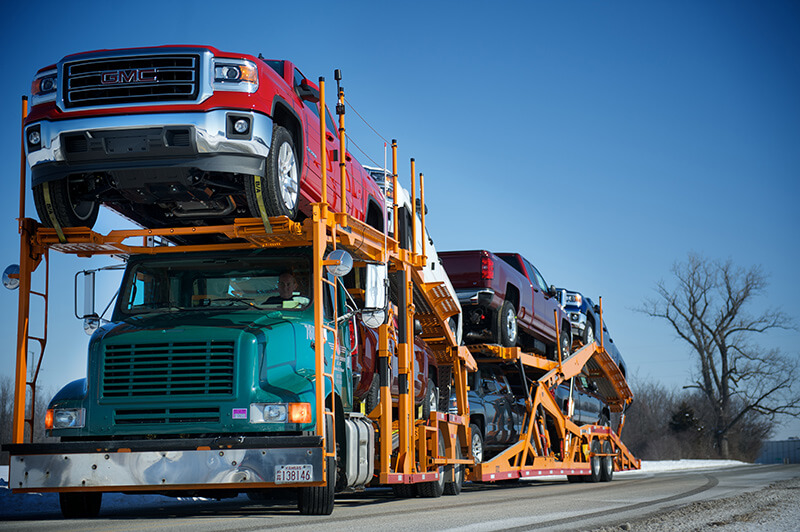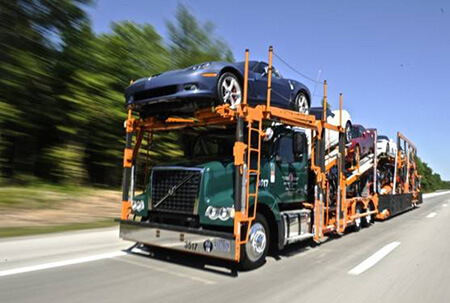 At the FVL North America conference, you said we were experiencing a technological revolution rather than an evolution. What do you think are the biggest changes happening now?I think we’ve got to look at it in our business from both sides: what’s happening in the actual vehicles and with the OEMs, but also in the trucking industry. Obviously, across the two we’re going to be keeping very close tabs on electrification and the implications for that in finished vehicle deliveries, particularly with respect to fuel economy savings, but also how that changes useable space with length and weight.
At the FVL North America conference, you said we were experiencing a technological revolution rather than an evolution. What do you think are the biggest changes happening now?I think we’ve got to look at it in our business from both sides: what’s happening in the actual vehicles and with the OEMs, but also in the trucking industry. Obviously, across the two we’re going to be keeping very close tabs on electrification and the implications for that in finished vehicle deliveries, particularly with respect to fuel economy savings, but also how that changes useable space with length and weight.
I think it’s a very exciting opportunity on the class 6, 7 and 8 truck side, certainly exciting to see what Tesla has announced [that it will make electric trucks]. At the same time, I think we are still a good number of years out to where electric vehicles will be the norm on the heavy trucking side.
On the automotive side, we are watching electrification in terms of how many new models the OEMs have announced and what the implications are for load factor and load efficiency, weight and certainly the change in any location of production and how that will impact our network logistics.
That’s the first trend that we’re watching and I think it’s a very near-term trend, but we’ve certainly got a good line of sight and a reasonable amount of time to adapt on that one. In terms of what’s happening in the immediate term, I’m very excited in particular about algorithmic route optimisation and certainly the potential to further improve upon that via machine learning.
Can you go into detail on the impact of carrying more EVs?On the heavy truck side, we certainly need to be paying attention in terms of whether or not electrified trucks take up incremental weight and length, versus our limits. The question is, both on the auto side and on the truck side, how much of the available weight limit will we eat up? In our business, you are typically paid by the VIN [vehicle identification number] but your costs are essentially structured per trip or load. Incremental vehicles on the car-haul trailer are a massive piece of profitability, which is a massive piece of your ability to reinvest in your equipment and to modernise your fleet.
My concern as we move toward electric vehicles, if they are heavier, is how will we adapt in terms of maintaining load factor? I think part of that might be done in certain locations by mixing the vehicles on the load, developing weight [limits] at a regulatory level, but I do think the question is really one of: does it take a hatchet to profitability?
Going back to the revolution/evolution idea, you expressed some scepticism about autonomous driving revolutionising the consumer side. Is autonomous driving an evolution, then?I would say for that one, it depends. The technology will precede the penetration of our industry. So it’s not just a question of: is the technology ready? It’s a question of whether or not those cars will load themselves onto the trucks, for example, which I do not believe they will. It’s a question of whether or not a fully autonomous truck would necessarily be without a driver, which I believe it would not.

In theory, airplanes could be fully autonomous but we still have two pilots in the cabin. It’s impossible to programme an algorithm to “pull a Sully” and land on the Hudson [the successful water landing of Flight 1549 by Captain Sullenberger in 2009]. It’s not even conceivable that that would be an option. I think people, for better or worse, will still want to have the security of knowing that there’s a human who can make a judgement call when necessary. Legal, regulatory and ethical frameworks that have yet to be developed will prevent this from being something that takes hold overnight.
The technology, on the other hand, could be a revolution. It could be something that happens very quickly – the ‘aha!” moment – something that helps do this in different weather conditions or makes the sensors more effective in a variety of conditions. That very well could be revolutionary. The evolutionary piece of it is, what do you do while you are turning over the vehicles that are on the road? For some period of time, presumably a decade or more, you’re going to have a mix of these vehicles with traditional, human-driven vehicles on the road.
The other thing is, I don’t believe this will be evenly developed in all geographies. In a more urban environment, I think you are going to have an autonomous revolution [but] in the rural [areas] I don’t imagine that people are going to leave their vehicles behind for self-driving cars any time soon, nor do I think you have the same level of necessity from a public transit point of view.
We tend to look at autonomous vehicles in a very monochromatic manner, but I think that’s a tremendous disservice to the industry. It’s going to vary by geography, by the type of vehicle and also in terms of the utility.
Autonomy is regarded by some as a potential solution to the current driver shortage in the US and elsewhere. If not through autonomy, how might the shortage be tackled?It very well could be that autonomous vehicles help us sort out a driver shortage – but I continue to believe it will be a very long time before we trust 80,000lbs and a couple of hundred thousand dollars’ worth of cars to a computer driving down the highway next to the bus of proverbial widows and orphans.
I do think it can help with the driver shortage but not in the way people are thinking, in terms of not needing a driver. It could help us recruit a new generation of drivers, when [truck-driving becomes] a tech-savvy role. The problem on the driver front isn’t just one of driver shortages, it’s one of an ageing driver force and not a lot of young people coming in under them, which is exacerbating the crisis. My argument would be, this could actually be something that makes these jobs not only desirable but potentially very much so and in a very sustainable way.
“It very well could be that autonomous vehicles help us sort out a driver shortage – but I continue to believe it will be a very long time before we trust 80,000lbs and a couple of hundred thousand dollars’ worth of cars to a computer driving down the highway next to the bus of proverbial widows and orphans.” - Sarah Amico, Jack Cooper
Now that we are talking about tech, can you explain how big data might improve supply chain efficiency?For me, the question is really: how efficiently can our networks function? If you think about the number of VINs that we touch and the number of data points that we have, that is a tremendous advantage in how we think about network economics. Because [with] those data sets, when they are run through the filter of a machine learning programme, for example, over time we can become smarter about how we are managing our network for optimal network efficiency.
My hope for the machine-learning era is that it enables us to optimally utilise equipment and drivers throughout the network. Even ten or 20 years ago, much of the industry functioned with just a dispatcher thinking about how to move the pieces through the network and we are necessarily limited in that model by human computational capacity.
What we’ve seen with the deployment of our [algorithmic route optimiser] Da Vinci tool is a tremendous pick-up in efficiency, in the ability to plan in the network. For example, when we know certain plants will be offline for model changeovers we’re able to fill in the gaps from a profitability, network efficiency and velocity standpoint. At the same time, when you have spikes in production or unexpected events like extreme weather, we are able to respond in a much more agile way than we would be able to with a series of dispatchers talking to one another, because it’s all calculated and quite precise.
What makes me excited about it is the ability to take the large number of interactions that we have with VINs – in our case we are moving north of 3.5m vehicles [and] we’ve been as high as 4.1m in some years – and to be able to eventually run predictive analytics. So, knowing that X number of weather events in Y number of weeks typically leads to a supply chain breakdown in A, B, C locations.
That’s the kind of tool that not only adds value to the carrier but potentially enables us to go back and speak with the manufacturer about what we are seeing across a number of producers in the automotive space and how the supply chain responds to various events. So for me, that’s probably the most efficient and immediate use of technology in revolutionising our industry.
I would say the immediate term is more the big data applications; medium term is how we deal with electrification; the long term is more how are we dealing with autonomous vehicles – understanding that, in finished vehicle logistics, we are uniquely positioned in the entire economy in that autonomous vehicle technologies will impact both our tractor-trailer combinations and our freight.
Looking at trends in consumer behaviour, what will rising shared usage of vehicles mean for the industry?In my generation, the day you turned 16 you went to take your driver’s test and you talked about it for six months before that. This generation that’s coming up now is different. A lot of them don’t go get their driver’s licence when they turn 16, or they’d rather take Uber. They really don’t have an interest in driving. And so it is a cultural shift of some sort.
This idea of not just ride sharing but potentially fractional or shared ownership is particularly interesting because the asset utilisation of vehicles is so low, particularly for such a large asset within our personal portfolios. But I would say that changes may come at a couple of different levels.
Number one, just like heavy trucks, as utilisation goes up, [cars] are going to wear out faster. And so, we would either see cars that are built in a much more utilitarian fashion for this sort of ownership or that are built in a much longer-lasting, durable way. Many people feel like ride sharing and shared ownership are somehow going to destroy automotive sales, and I completely disagree, because the more our trucks run, the faster we have to replace them, and it’s no different for a car. You are going to be looking at a much higher churn through the vehicles.
“Many people feel like ride sharing and shared ownership are somehow going to destroy automotive sales, and I completely disagree, because the more our trucks run, the faster we have to replace them, and it’s no different for a car. You are going to be looking at a much higher churn through the vehicles.” - Sarah Amico, Jack Cooper
I do think we need to look at average vehicles per household [and] whether or not the trend of ride sharing in particular has some near-term implications for aggregate sales. But we’re also overestimating what percentage of the country this will impact over the next ten years. We need to look at this as something that doesn’t impact the entirety of the US let alone the global marketplace in the same way. It’s not monolithic.
You are now running a campaign to become Lieutenant Governor of Georgia. What have you learned at Jack Cooper that would inform your work in a political role?I think the most important thing is that I don’t believe in unsolvable problems. When our family first bought into a car-haul company it was 2008, it was in the middle of the financial collapse and people thought we couldn’t succeed, that we would all be bankrupt and we were throwing away our opportunities, money, careers.
And a year later, we had the opportunity to buy Jack Cooper from the third generation of the Cooper family and again people said ‘we are not sure these jobs are saveable, we are not sure this company is fixable, we’re not sure why you would want to try’. And we smiled politely and said ‘we think there’s something worth saving here’.
About a month after we bought Jack Cooper, the GM and Chrysler bankruptcies happened. And yet, here we are, ten years after we bought our first car-haul company; we’ve not only succeeded and survived but we’ve actually been able to grow the business in a sustainable manner, we’ve built an incredible team and we’ve tried to do everything honourably and with the right values.
 Autonomous features could help to attract younger drivers to trucking, suggests Amico
Autonomous features could help to attract younger drivers to trucking, suggests AmicoIf you succeed in becoming Lieutenant Governor, what will you do to try to benefit the logistics sector?I think the most important thing is infrastructure investment. The Infrastructure Report Card that came out last year had over 9% of our bridges being structurally deficient in some manner, the average age being north of 40 years. These are just unacceptable numbers! We’ve got to put the kind of infrastructure in place that will enable a 21st-century economy. So with the logistics sector that’s obviously investment in bridges, roads and ports. But there are other aspects to infrastructure [including] proper access to broadband.
Looking at the wider context, there is some political uncertainty at the moment. Are you worried by possible changes to Nafta?Absolutely! Anybody in our industry who’s not watching that should be. This is the stuff that economic shocks are made of. I’m concerned that we’ve lost sight of how to be a leader in free trade and entrepreneurship and free markets. I’m concerned [about] the message that sends the rest of the world.
We’ve seen some movement – Canada and Mexico have already been exempted, and it looks like Europe will be on some of the tariffs. There’s a good argument to be made that China maybe has to end up paying and should be subject to penalties or tariffs. I’m not saying, as a blanket statement, this isn’t a tool that a government should have. I’m saying that the lack of predictability is concerning in that it undermines the stability of financial markets, and when you start to look at tinkering with Nafta in a way that could completely undermine the principles of the original [deal] it’s potentially devastating to a whole bunch of industries.
What can logistics providers do to protect themselves in this time of uncertainty?I think, as a business, you just need to be aware. For a long time, many of us in the US have been able to assume that the system, barring the uncertain and unexpected – September 11, the Lehman Brothers collapse – is essentially self-sustaining and will keep chugging along, [that] there will be those occasional tragedies and unexpected events but we’re very resilient – and fundamentally, I do believe that. We have a remarkably resilient system of government and economy.
But I think now the game is a little bit different. We all have to be aware of what’s happening and willing to participate and to show up – whether that’s at a voting booth or an industry conference to make our voices heard.


























![Global[1]](https://d3n5uof8vony13.cloudfront.net/Pictures/web/a/d/s/global1_726550.svgz)









